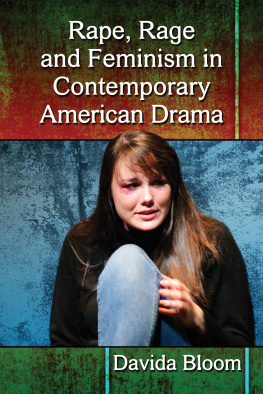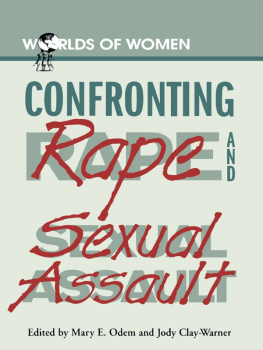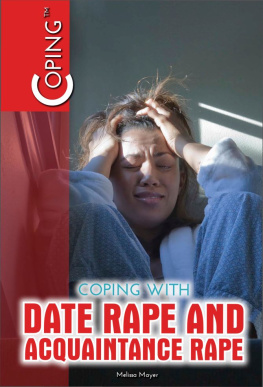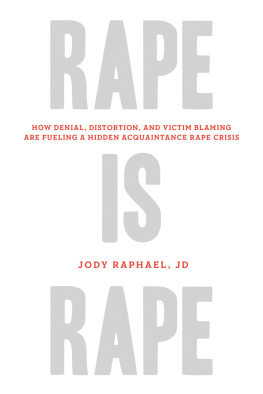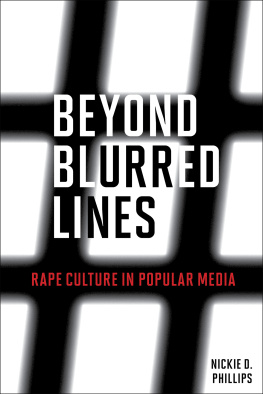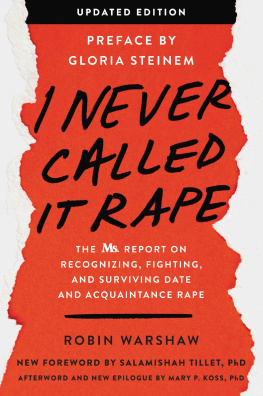
For all the theatre artists who have,
and will, put the complex issues surrounding rape
and the need to transform our rape culture
center stage
Acknowledgments
A book, like a dramatic text, goes through an extensive revision process and there are many people who have helped me along the way. The first incarnation of this work was carefully guided by Lee Potts, Haiping Yan, Alison Jaggar, Karen Jacobs, and Merrill Lessley. I am also very grateful to Elaine Aston, who was the first to suggest I explore the intersections of the depiction of rape in dramatic texts and the various waves of feminism. I am indebted to my mother, Joan Bloom, and my sister, Claire Bloom, for their careful proofreading, and my father, Bernard Bloom, for his support and encouragement. The Interlibrary Loan librarians at the University of Colorado and the College at Brockport: State University of New York were essential to my research and I am most grateful for their hard work. And finally, Id like to thank the two anonymous readers of my manuscript whose insights resulted in a much-improved work. On a personal note I would like to thank my son Keenan. You did not get as much of my time as you deserved because of this project. My sincere apologies. You have become an extraordinary young man and I am very proud of you.
Preface
Lynda Hart, in the introduction to the book Acting Out: Feminist Performances, writes, Getting raped, going crazy, and, of course dyingthis is what women appear to do most often in realistic theatre (5). In this study I examine the depiction of rape in 36 American dramas, written between 1970 and 2007. As I will document, the portrayal of rape, raped women, and rapists in these dramas reveals much about the cultural gendering of sexuality and expectations of masculine and feminine identity in the United States. In addition, the gendering of rage in our culture is explored in relation to the portrayal of sexual violence and the representation of a raped womans response to her assault. Furthermore, I expose the prevalence of commonly accepted rape myths in these plays, such as women who dress provocatively and invite men into their homes deserve to be raped, along with equally frequent occasions in which these myths are contested. Finally, since feminism and womens activism has markedly transformed American society and artistic output, including American dramas about rape, I begin my study with the portrayal of rape in contemporary dramatic texts in the 1970s, when the feminist movement focused attention on the issue of rape in our society. Throughout this study, I will demonstrate the impact of second-wave feminism, antifeminist backlash, third-wave, and postfeminism on the depiction of rape in these dramas.
Limitations, Terminology and Structural Overview
I have limited the scope of my investigation in several ways. First, I have limited this study to the analysis of the dramatic texts. While I do at times discuss productions of selected plays based on firsthand accounts (reviews or scholarly criticism about a performance), my primary focus is the text itself.
Second, for a play to be included in this study, the rape (or attempted rape) depicted or discussed in the play needs to meet the following definition of rape: A sexually penetrating act (not limited to penetration of the vagina or the involvement of a penis) perpetrated on a non-consenting woman through the use or threat of force, or other forms of coercion such as physical pressure or psychological intimidation. Also included is the situation in which a perpetrator engages in a sexually penetrating act on a woman who is incapacitated or otherwise unable to give consent. In the case of attempted rape, as long as it is clear that the rapist intended to perpetrate a rape as defined above, the play was included in this study.
Third, I have limited my study to the examination of dramatic texts that depict female rape. While I acknowledge that male rape is a problem and its depiction worthy of investigation, I agree with Nicola Gavey when she writes, Despite moves within official discourse to increasingly gender neutralize the categories of victim and perpetrator, I would argue that with reference to sexual violence they are still coded as female and male respectively, in the public imagination (Fighting Rape, 116117). In other words, many of the conclusions I draw in terms of the representation of raped women may also apply to raped males in dramatic texts, and I look forward to reading future research in this area.
Fourth, I have limited the scope of this study to the depiction of the rape of a female who is characterized as a young woman or older, as opposed to plays depicting child sexual abuse. As with male rape, the depiction of child sexual abuse in contemporary American dramas is an area ripe for further investigation.
Fifth, I have focused on dramatic texts written by American playwrights that take place in the United States, or if set in another country, that include a protagonist from the United States. And finally, I have limited this study to the depiction of rape in contemporary American dramas; therefore, musicals and other theatrical genres have been excluded.
Scholars use the terms victim and survivor somewhat interchangeably, with no perceivable consistency throughout the field. I agree with Sharon Lambs point that the term victim is a product of social relations, culture, and language (Introduction, 3). I would add that the term survivor has likewise been socially constructed. Given that there will be no consistent use of these terms by the scholars to whom I will refer in this book, I will use the term raped woman to avoid any unintended layering of socially constructed meaning. Furthermore, I have chosen to omit the hyphen which is often (but not universally) included in the word postfeminism. I have made this choice in order to avoid the implication that feminism has achieved its objectives and is no longer relevant.
In Chapter One, I present an overview of second-wave feminism, feminist anti-rape activism, and theatrical manifestations of this activism beginning in the 1970s. In Chapter Two, I discuss the prevalence of rape myths, in both American culture and American drama. Additionally, I look at the depiction of rapists in a number of plays. In Chapter Three, I describe the representation of raped characters rage in selected plays, both in terms of how female rage is contained and how it is demonized. In Chapter Four, I return to the influence of feminism on the depiction of rape and I examine the ways in which the antifeminist backlash of the 1980s is evident in selected plays. Chapter Five continues the exploration of feminism as I shed light on both third-wave feminism and postfeminism and detail the ways in which these movements are apparent in plays about rape written since the late 1980s. In Chapter Six, I return to the expression of female rage focusing on texts in which the active expression of rage by a raped character is presented as part of their path to healing.
Throughout this study I revisit several overarching themes, including the gendering of sexuality, violence, and rage; the acceptance of cultural myths about rape, raped women, and rapists; and the ways in which movements within feminism are all evident in dramatic texts.
Introduction
Research has shown that approximately 12 percent, or one in every eight women, will develop breast cancer at some time in their lives. The ubiquity of pink ribbons and race-for-the-cure events keeps the issue of breast cancer on the front burner. I do not in any way mean to diminish the importance of breast cancer awareness and research, but the truth is there are no colored ribbons on yogurt containers to raise money to bring an end to rape.
Next page
